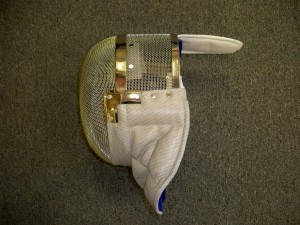
How to Fit Your Mask
Sizing for fencing masks are based on your vertical head circumference. Measure your head by taking a tape measure, holding it underneath your chin, from under your jaw, up past your ear, past the top of your head, down past your other ear, and back down to the bottom of your chin (from where you started). Take that measurement and use the table below to find your approximate mask size:
- Under 21.5”: X-Small
- 22-23”: Small
- 24-25”: Medium
- 26-28”: Large
- 30” and up: X-Large
How to Adjust Your Mask
A mask may fit the vertical circumference of your head, but may not fit quite as well in other areas. Masks can be adjusted to fit your individual head.When you first receive the mask, the “tongue”of the mask may be completely straight. The tongue of the mask is really the thing that keeps your head inside the mask when you’re moving back and forth on strips, so prior to fencing, the tongue must be bent down to a comfortable position to ensure a safe fit. The exact position of the tongue varies from person to person. Use the following technique to bend the tongue to your liking:
1) Place the mask between your knees, with the tongue facing outwards and the bib pointed at the floor. Place both palms on the top of the tongue with your thumbs pointed outward.
2) While keeping pressure on the mask with your knees (so the mask doesn’t slip out), bend the tongue downwards from the edge of the wire mesh. Stop at approximately a 45 degree angle. The bend of the tongue should be made at the edge of the wire mesh.
3) The mask may fit your head from top to bottom, but it maybe too wide (i.e. too much space on the sides).With the mesh facing up, place the mask under your dominant arm in a “headlock” position. Squeeze gently by bringing your dominant arm closer to your body. Check the fit and continue to adjust as needed.